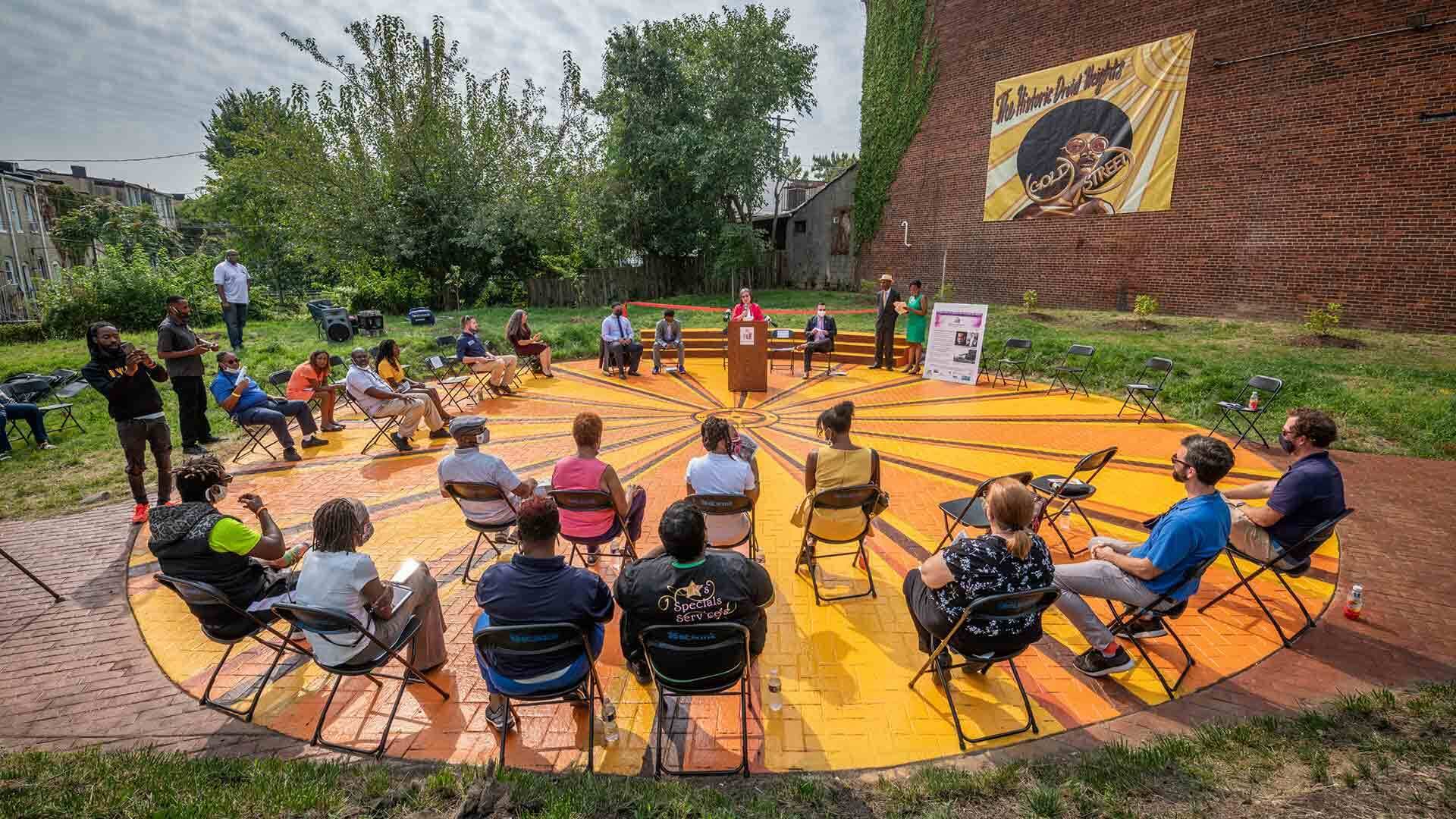Striking ‘Gold’ With New Baltimore Park
Landscape Architecture Students Help Neighborhood Turn Former Dump Site Into Jewel

Attendees on Sept. 14 celebrate the opening Gold Street Park, a new community space in Baltimore's Druid Heights neighborhood that UMD students worked with community members to help design.
Photo by Edwin Remsberg
A vacant lot in Baltimore has been reinvented as an environmentally friendly park where residents can enjoy nature, take in musical performances and art and hold outdoor church services, following years of effort by University of Maryland students working with community members and organizations.
Gold Street Park, which opened last month at the corner of Division Street in the historic Druid Heights neighborhood, is a public green space with a stage, rain garden, meditation space, winding brick sidewalks and murals, designed in large part by graduate students in landscape architecture.
“Communities like Druid Heights cannot afford professional landscape architecture services, so it was a great opportunity for my students to make a difference in the lives of people who really need it,” said Byoung-Suk Kweon, associate professor of landscape architecture, who led the project. “We are improving quality of life and contributing to a healthier Chesapeake Bay, which are both immensely important and rewarding pursuits.”
The community has a storied past as a hub for African American life and culture, with dance halls and movie houses, churches, The Afro-American newspaper and housing for well-to-do professionals. But Druid Heights has since suffered from poverty and blight, and the site of the new park was a shuttered coal yard that had become a dumping ground.
“You could find at least 25 mattresses, car tires and 50 bags of trash on a daily basis,” Anthony Pressley, executive director of the nonprofit Druid Heights Community Development Corp., told WBAL-TV at the park’s grand opening. “We actually saw trucks backing in and dumping here.”
Maryland students in Kweon’s landscape architecture design studio project held listening sessions with residents in 2015 to come up with the initial park concept, with the goals of meeting the community’s needs, improving the quality of life and promoting prosperity.
The design by Jason Poole, Jennifer Ren and Laura Robinson, with drawings by Vince (Che-Wei) Yi, won the 2016 Sustainable Growth Challenge Award, a project through which the Maryland Sustainable Growth Commission engages Maryland college students to incorporate sustainable growth into their solutions, while also providing them with career-building, real-world experiences.
“When it comes to designing community spaces, you first listen to the community’s wants and needs and then balance that with what the environmental factors of the site allow,” Robinson said. “The fact that this went from design to completion really shows the perseverance of the community and how much dedication and effort went into this project by so many different groups.”
The project was funded by a $100,000 grant from the Baltimore City Department of Housing and Community Development, $50,000 from the Maryland Department of Housing and Community Development, a $58,000 Chesapeake Bay Green Streets, Green Jobs, Green Towns grant from the U.S. Environmental Protection Agency and $50,700 from the Chesapeake Bay Trust. Residents have since also hosted volunteer cleanups, watered the landscaping, and planted 128 new trees, shrubs and herbs.
The opening, which followed UMD’s participation in Archway Park in Druid Heights in 2019, featured Baltimore Mayor Brandon Scott, City Council President Nick Mosby and Craig Beyrouty, dean of UMD’s College of Agriculture and Natural Resources.
“Gold Street Park is symbolic of a great community that went through serious decline but is now beginning to see new life,” Kweon said. “When multiple agencies come together to solve problems, like Chesapeake Bay Trust, the city of Baltimore, CityScape Engineering and others, great things can happen.”